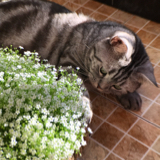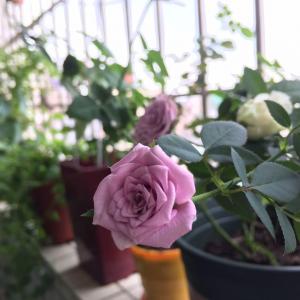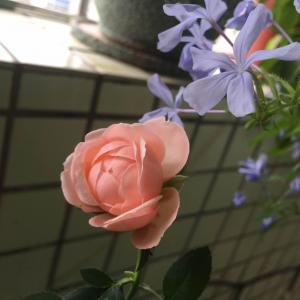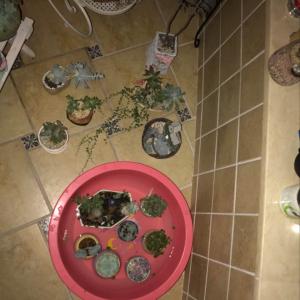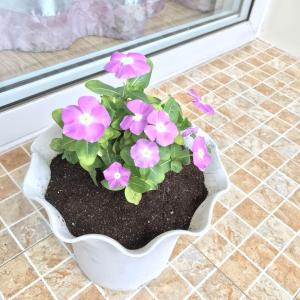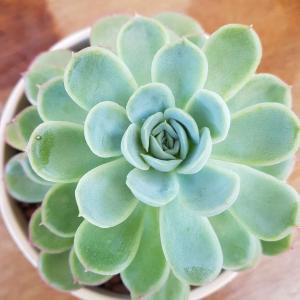文章
Dummer. ゛☀
2017年07月27日

Family - Geraniaceae
Stems - To 60cm tall, erect,multiple from base, herbaceous, hirsute to retrorse pubescent, angled, from rhizomes.
Leaves - Opposite, petiolate. Petioles to 30cm long(on basal leaves), shorter above, hirsute. Blades palmately 5-7-lobed, pubescent. Lobes with margins entire in basal half, coarse serrate and often lobed in upper half. Margins antrorse strigose.
nflorescence - Terminal corymb of 1-4 flowers. Pedicels erect, hirsute. Each division subtended by linear bracts to 7mm long.
Flowers - Petals 5, free, obovate, cuneate, to 2cm long, 1.5cm broad, glabrous, rounded to emarginate or truncate at apex, lilac to rose-purple. Stamens 10, 5 with glandular bases. Filaments broad and ciliate-margined at base, to 6mm long, tuberculate above, white. Anthers 1.5mm broad, 3mm long, light brown. Carpels 5. Styles to 2mm long, connate. Stigma 5-lobed. Sepals 5, free, imbricate, elliptic-ovate, entire, glabrous externally, dense pubescent internally, aristate, to 1.3cm long (including arista), 4mm broad. Margins long ciliate. Fruit erect, with long style column, pubescent. Seeds to 3mm long, glabrous.
Flowering - April - June.
Habitat - Rich to rocky open woods, thickets, ravines.
Origin - Native to U.S.
Other info. - This is a common plant in Missouri and can be found throughout the entire state. The plant is becoming popular in cultivation also because of its striking purplish flowers. There is a white flowered form, form albiflorum (Raf.) House, which has not been found in Missouri. Our plants belong to form maculatum.
The plant is super high in tannins and has been used medicinally to treat diarrhea, gum diseases, canker sores, and many other ailments.
Stems - To 60cm tall, erect,multiple from base, herbaceous, hirsute to retrorse pubescent, angled, from rhizomes.

Leaves - Opposite, petiolate. Petioles to 30cm long(on basal leaves), shorter above, hirsute. Blades palmately 5-7-lobed, pubescent. Lobes with margins entire in basal half, coarse serrate and often lobed in upper half. Margins antrorse strigose.

nflorescence - Terminal corymb of 1-4 flowers. Pedicels erect, hirsute. Each division subtended by linear bracts to 7mm long.
Flowers - Petals 5, free, obovate, cuneate, to 2cm long, 1.5cm broad, glabrous, rounded to emarginate or truncate at apex, lilac to rose-purple. Stamens 10, 5 with glandular bases. Filaments broad and ciliate-margined at base, to 6mm long, tuberculate above, white. Anthers 1.5mm broad, 3mm long, light brown. Carpels 5. Styles to 2mm long, connate. Stigma 5-lobed. Sepals 5, free, imbricate, elliptic-ovate, entire, glabrous externally, dense pubescent internally, aristate, to 1.3cm long (including arista), 4mm broad. Margins long ciliate. Fruit erect, with long style column, pubescent. Seeds to 3mm long, glabrous.

Flowering - April - June.
Habitat - Rich to rocky open woods, thickets, ravines.
Origin - Native to U.S.
Other info. - This is a common plant in Missouri and can be found throughout the entire state. The plant is becoming popular in cultivation also because of its striking purplish flowers. There is a white flowered form, form albiflorum (Raf.) House, which has not been found in Missouri. Our plants belong to form maculatum.
The plant is super high in tannins and has been used medicinally to treat diarrhea, gum diseases, canker sores, and many other ailments.
0
0
文章
Dummer. ゛☀
2017年07月26日

Family - Ranunculaceae
Stems - Sprawling to climbing, herbaceous, glabrous or with a few hairs at nodes, terete ar with rounded angles, reddish-brown, branching.

Leaves - Opposite. odd-pinnately compound with 3-7 leaflets. Petiolules of lateral leaflets to 2cm long. Petiolule of terminal leaflet longer. Leaflets entire, ovate to rotund, blunt at apex, mucronate, glabrous above, glabrous or with a few sparse hairs below, glaucous below, to +6cm long, +4.5cm broad. Terminal leaflet twining.

Inflorescence - Single pedunculate flowers from leaf axils. Peduncles subtended by a pair of foliaceous bracts. Peduncles to 10cm long, purple, glabrous, bent at apex.
Flowers - Apetalous, urcreolate. Sepals 4, thick, spongy, purple at base fading to greenish-white at apex externally, white internally, joined near base, recurving at apices, acute, to +2cm long, 1cm broad at base. Stamens many (+50), included. Filaments to 1.2cm long, pubescent, creamy white. Anthers pale yellow, .7mm long. Pistils dense villous for entire length, 1.6cm long.

Flowering - May - June.
Habitat - Rocky open woods, bluff ledges, rocky ravines.
Origin - Native to U.S.
Other info. - In Missouri, there are a few species of these purple flowered Clematis that look alike. When I get them all posted you can see the differences for yourself.
C. versicolor is a striking plant and is being used in cultivation. It is found in south-central Missouri in the Ozarks. It seems to prefer locations with a shady northern or eastern exposure.
Stems - Sprawling to climbing, herbaceous, glabrous or with a few hairs at nodes, terete ar with rounded angles, reddish-brown, branching.

Leaves - Opposite. odd-pinnately compound with 3-7 leaflets. Petiolules of lateral leaflets to 2cm long. Petiolule of terminal leaflet longer. Leaflets entire, ovate to rotund, blunt at apex, mucronate, glabrous above, glabrous or with a few sparse hairs below, glaucous below, to +6cm long, +4.5cm broad. Terminal leaflet twining.

Inflorescence - Single pedunculate flowers from leaf axils. Peduncles subtended by a pair of foliaceous bracts. Peduncles to 10cm long, purple, glabrous, bent at apex.
Flowers - Apetalous, urcreolate. Sepals 4, thick, spongy, purple at base fading to greenish-white at apex externally, white internally, joined near base, recurving at apices, acute, to +2cm long, 1cm broad at base. Stamens many (+50), included. Filaments to 1.2cm long, pubescent, creamy white. Anthers pale yellow, .7mm long. Pistils dense villous for entire length, 1.6cm long.

Flowering - May - June.
Habitat - Rocky open woods, bluff ledges, rocky ravines.
Origin - Native to U.S.
Other info. - In Missouri, there are a few species of these purple flowered Clematis that look alike. When I get them all posted you can see the differences for yourself.
C. versicolor is a striking plant and is being used in cultivation. It is found in south-central Missouri in the Ozarks. It seems to prefer locations with a shady northern or eastern exposure.
0
0
文章
Dummer. ゛☀
2017年07月26日

Family - Euphorbiaceae
Stems - To 5m tall, glabrous, glaucous, suffrutescent (with age) or entirely herbaceous, branching, reddish, greenish, or purplish.
Leaves - Alternate, peltate, long petiolate, palmately 5 to 7 lobed, toothed, glabrous, to +30cm broad.

Inflorescence - Axillary racemes or loose panicles to +50cm tall, on thick peduncle.
Staminate Flowers - At base or lower portion of inflorescence, apetalous, pedicillate. Calyx typically 5-parted, reflexed. Stamens many, the filaments branching. Anthers yellow.
Pistillate Flowers - Capsules red, green or purple, covered with dense spines, +1.5cm in diameter, 3-seeded. Seeds mottled with copper, black, and bronze colors. Styles 3, red.

Flowering - August - November.
Habitat - Mostly cultivated. Also escaped to roadsides, railroads, waste ground, disturbed sites.
Origin - Native to Asia.
Other info. - This plant is the source of castor beans (used in ornamentation) and castor oil(pressed from the seeds). The plant is also more toxic than any other plant to humans. The seed cake which is left over after pressing contains a protein toxin known as Ricin which replaces a vital enzyme in cellular metabolism causing the shutdown of protein synthesis in the body. No protein - no life. The toxin contains an alpha section, which causes the cell shutdown, and a beta section which carries the molecule across the cell membrane.
Ricin has been used for assassinations, and has been experimented with for biological warfare. The LD 50 of Ricin is around 1/1000000 of the animals weight. It is VERY toxic. Pests which feed on the plant are usually killed.
The entire plant is toxic, but the seeds more than any other part.
The plant is, however, very striking in cultivation and many horticultural varieties exist. The typical species is mostly a green plant but I have found that the red form is very common in Missouri so I placed the plant in the red flowers section of this site.
The name Ricinus communis means "common tick" because the seeds resemble ticks.
Red variety photos taken at Powell Gardens, 9-2-99. Typical species photos taken off Cypress Gardens Blvd., Winter Haven, FL., 3-26-00.
Stems - To 5m tall, glabrous, glaucous, suffrutescent (with age) or entirely herbaceous, branching, reddish, greenish, or purplish.
Leaves - Alternate, peltate, long petiolate, palmately 5 to 7 lobed, toothed, glabrous, to +30cm broad.

Inflorescence - Axillary racemes or loose panicles to +50cm tall, on thick peduncle.
Staminate Flowers - At base or lower portion of inflorescence, apetalous, pedicillate. Calyx typically 5-parted, reflexed. Stamens many, the filaments branching. Anthers yellow.
Pistillate Flowers - Capsules red, green or purple, covered with dense spines, +1.5cm in diameter, 3-seeded. Seeds mottled with copper, black, and bronze colors. Styles 3, red.

Flowering - August - November.
Habitat - Mostly cultivated. Also escaped to roadsides, railroads, waste ground, disturbed sites.
Origin - Native to Asia.
Other info. - This plant is the source of castor beans (used in ornamentation) and castor oil(pressed from the seeds). The plant is also more toxic than any other plant to humans. The seed cake which is left over after pressing contains a protein toxin known as Ricin which replaces a vital enzyme in cellular metabolism causing the shutdown of protein synthesis in the body. No protein - no life. The toxin contains an alpha section, which causes the cell shutdown, and a beta section which carries the molecule across the cell membrane.
Ricin has been used for assassinations, and has been experimented with for biological warfare. The LD 50 of Ricin is around 1/1000000 of the animals weight. It is VERY toxic. Pests which feed on the plant are usually killed.
The entire plant is toxic, but the seeds more than any other part.

The plant is, however, very striking in cultivation and many horticultural varieties exist. The typical species is mostly a green plant but I have found that the red form is very common in Missouri so I placed the plant in the red flowers section of this site.
The name Ricinus communis means "common tick" because the seeds resemble ticks.
Red variety photos taken at Powell Gardens, 9-2-99. Typical species photos taken off Cypress Gardens Blvd., Winter Haven, FL., 3-26-00.
0
0
文章
Dummer. ゛☀
2017年07月26日

Family - Fabaceae
Stems - Twining, thin, herbaceous, glabrous to appressed pubescent, terete, from rhizomes. Rhizomes often thickened into large tubers to +/-5cm in diameter.
Leaves - Alternate, odd pinnate with 3-7 leaflets, stipulate. Stipules linear, 5-6mm long, pubescent. Petiole thickened at base for 6-7mm, glabrous to sparse appressed pubescent, to +/-6cm long, with adaxial groove. Leaflets on short petiolules to 4mm long. Lateral leaflets ovate to ovate-lanceolate, entire, with some cilia on margins, glabrous above, glabrous to sparse pubescent below, acute to acuminate, to +6cm long, +2.5cm broad. Terminal leaflet more broad than lateral leaflets, on petiolule to 1.5cm long.

Inflorescence - Axillary pedunculate racemes to +/-8cm long. Peduncles typically glabrous, to 5cm long. Pedicels to 4mm in flower, subtended by small pubescent bract, with prominent gland in axil with stem.

Flowers - Corolla papilionaceous. Standard reflexed, deep purplish-maroon internally, lighter externally, whitish at base, 1cm long, 1.1cm broad. Wings deep brownish-purple. Keel lighter than other petals, greatly incurved, apex of keel tucked against the standard. Stamens 10, diadelphous. Stamen tube(connected filaments) white, glabrous. Anthers yellowish, .2mm long. Ovary pale green, 5-6mm long, pubescent. Style coiled as keel petals, white with green at apex, pubescent. Calyx glabrous, tubular, bilabiate. Upper lip with 3 lobes. Central lobe acute, 1.8mm long, with sparse pubescence externally. Lateral two lobes smaller, .6mm long. Lower lip with two shallow lobes. All lobes with minutely lacerate margins. Calyx tube 3mm long, green with some reddish tinge, glabrous internally. Fruit to +/-6cm long, -1cm broad.

Flowering - June - September.
Habitat - Wet meadows, streambanks, pond margins, moist woodlands.
Origin - Native to U.S.
Other info. - The plants thickened rhizome portions were a big hit amongst the Indians and used by settlers in this area. The rhizomes contain up to 3 times the protein of potatoes and can be boiled, fried, or roasted. The seeds are edible also. The plant is a fast growing perennial and, as stated above, prefers moist areas. I ate some of the rhizomes from this very plant while camping. I must admit, they could have used a little salt.
Stems - Twining, thin, herbaceous, glabrous to appressed pubescent, terete, from rhizomes. Rhizomes often thickened into large tubers to +/-5cm in diameter.
Leaves - Alternate, odd pinnate with 3-7 leaflets, stipulate. Stipules linear, 5-6mm long, pubescent. Petiole thickened at base for 6-7mm, glabrous to sparse appressed pubescent, to +/-6cm long, with adaxial groove. Leaflets on short petiolules to 4mm long. Lateral leaflets ovate to ovate-lanceolate, entire, with some cilia on margins, glabrous above, glabrous to sparse pubescent below, acute to acuminate, to +6cm long, +2.5cm broad. Terminal leaflet more broad than lateral leaflets, on petiolule to 1.5cm long.

Inflorescence - Axillary pedunculate racemes to +/-8cm long. Peduncles typically glabrous, to 5cm long. Pedicels to 4mm in flower, subtended by small pubescent bract, with prominent gland in axil with stem.

Flowers - Corolla papilionaceous. Standard reflexed, deep purplish-maroon internally, lighter externally, whitish at base, 1cm long, 1.1cm broad. Wings deep brownish-purple. Keel lighter than other petals, greatly incurved, apex of keel tucked against the standard. Stamens 10, diadelphous. Stamen tube(connected filaments) white, glabrous. Anthers yellowish, .2mm long. Ovary pale green, 5-6mm long, pubescent. Style coiled as keel petals, white with green at apex, pubescent. Calyx glabrous, tubular, bilabiate. Upper lip with 3 lobes. Central lobe acute, 1.8mm long, with sparse pubescence externally. Lateral two lobes smaller, .6mm long. Lower lip with two shallow lobes. All lobes with minutely lacerate margins. Calyx tube 3mm long, green with some reddish tinge, glabrous internally. Fruit to +/-6cm long, -1cm broad.

Flowering - June - September.
Habitat - Wet meadows, streambanks, pond margins, moist woodlands.
Origin - Native to U.S.
Other info. - The plants thickened rhizome portions were a big hit amongst the Indians and used by settlers in this area. The rhizomes contain up to 3 times the protein of potatoes and can be boiled, fried, or roasted. The seeds are edible also. The plant is a fast growing perennial and, as stated above, prefers moist areas. I ate some of the rhizomes from this very plant while camping. I must admit, they could have used a little salt.
0
0
文章
权问薇
2017年07月24日


九里香的养护
土壤
九里香的培养土可用沙土、细炉渣、饼肥渣、塘泥、泥炭、河沙等六种原料以7:1:2:4:1的份数比例混合。盆地施含有磷钾肥的有机肥,增强迟效性,土壤砂质一定要有良好的排水性。
施肥
每两到三年追施一次有机的肥料,更换一次盆。5月是九里香的生长期,施肥加至每周一次,浓度也相应增加。
浇水
生长期每月给水一次,不宜过多。花期给水不仅要及时,而且要适量,这样才能保证花开的时候会更多、味道会更香。

光照
九里香是喜阳植物,全日照为好,光线稍差也不会影响太大。
温度
九里香抗寒行较好,喜温又喜热。18-28℃最佳,冬季温度5℃以下会影响生长。
九里香养殖的注意事项
初栽时需要盆地放置一些基肥。管理三怕,怕湿、怕冷、怕曝晒。多用有机肥、少用慎用化肥。

1
2
文章
Dummer. ゛☀
2017年07月24日

Family - Rosaceae
Stems - Woody, with dense straight prickles, hirsute, erect to clambering, to +1m tall. Prickles pubescent (at least at base).

Leaves - Alternate, odd-pinnate, with 5-7 leaflets. Stipules to 3cm long, 1cm broad, ciliate and glandular margined, glandular and pubescent below, glabrous above. Leaf rachis with prickles below, densely pubescent. Leaflets elliptic to rotund, crenate-serrate, glandular and pubescent below, glabrous and shiny above, rugose, 5-6cm long, 3-4cm broad.

Inflorescence - Single flowers from upper leaf axils. Peduncles to 1.7cm long, 3mm in diameter, densely glandular pubescent and non-glandular pubescent.
Flowers - Petals 5, rose, 4.5cm broad, 4cm long, free, glabrous, emarginate to obcordate, scented. Stamens very many (+100). Filaments white, glabrous, 6-7mm long. Anthers yellow, 2.1mm long, 1.2mm broad. Sepals 5, alternating with petals, lanceolate, joined at base, densely glandular pubescent below, pubescent above and on margins. Hypanthium subglobose, somewhat flattened, glaucous to moderately covered with prickles. Seeds many, crinite, with a hornlike protrusion.

Flowering - May - September.
Habitat - Cultivated and rarely escaped.
Origin - Native to Asia.
Other info. - I first read about R. rugosa in "This Old House Magazine", Sept./Oct. 1996. It's a great article and talks about the history and uses of the plant. Apparently the plant is quite popular on the island of Nantucket.
Personally, I'm not a huge rose fan, but this plant is nice. Nice to look at perhaps, but don't touch it. The stems are dense with stiff prickles. They may not be hooked prickles, but they can do damage none the less.
Stems - Woody, with dense straight prickles, hirsute, erect to clambering, to +1m tall. Prickles pubescent (at least at base).

Leaves - Alternate, odd-pinnate, with 5-7 leaflets. Stipules to 3cm long, 1cm broad, ciliate and glandular margined, glandular and pubescent below, glabrous above. Leaf rachis with prickles below, densely pubescent. Leaflets elliptic to rotund, crenate-serrate, glandular and pubescent below, glabrous and shiny above, rugose, 5-6cm long, 3-4cm broad.

Inflorescence - Single flowers from upper leaf axils. Peduncles to 1.7cm long, 3mm in diameter, densely glandular pubescent and non-glandular pubescent.
Flowers - Petals 5, rose, 4.5cm broad, 4cm long, free, glabrous, emarginate to obcordate, scented. Stamens very many (+100). Filaments white, glabrous, 6-7mm long. Anthers yellow, 2.1mm long, 1.2mm broad. Sepals 5, alternating with petals, lanceolate, joined at base, densely glandular pubescent below, pubescent above and on margins. Hypanthium subglobose, somewhat flattened, glaucous to moderately covered with prickles. Seeds many, crinite, with a hornlike protrusion.

Flowering - May - September.
Habitat - Cultivated and rarely escaped.
Origin - Native to Asia.
Other info. - I first read about R. rugosa in "This Old House Magazine", Sept./Oct. 1996. It's a great article and talks about the history and uses of the plant. Apparently the plant is quite popular on the island of Nantucket.
Personally, I'm not a huge rose fan, but this plant is nice. Nice to look at perhaps, but don't touch it. The stems are dense with stiff prickles. They may not be hooked prickles, but they can do damage none the less.
0
0


